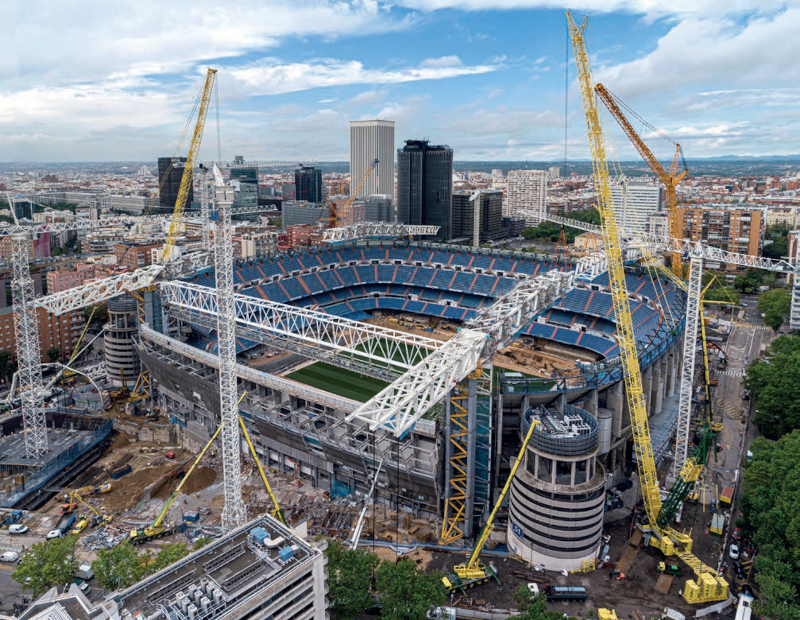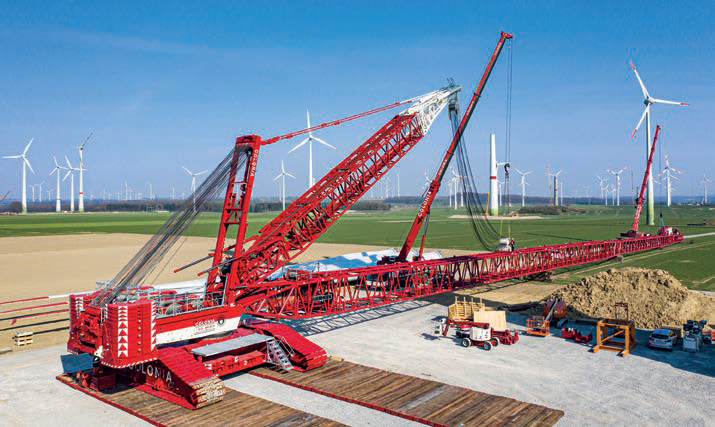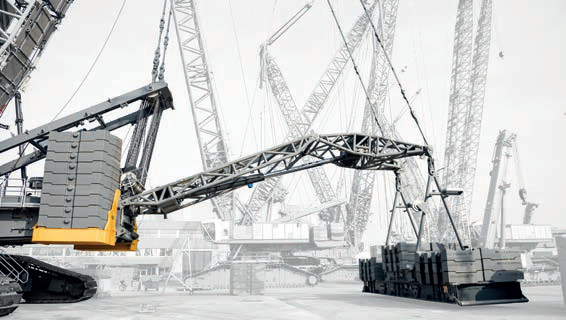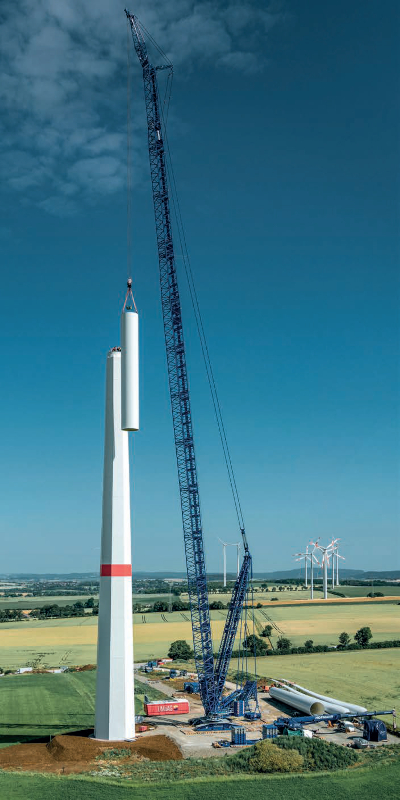Logical progression
29 April 2022Stuart Anderson charts Liebherr’s logical development of large crawler cranes.
Last October saw the delivery of the third 1,000-tonne Liebherr LR 11000 crawler crane to the leading Austrian crane rental and heavy transport group Felbermayr. Having been one of the very first companies to purchase an LR 11000 in 2014, this latest delivery illustrates the continued expansion of the wind power market as well as the growth in the height and power of wind turbines and commensurate size of the cranes needed to perform this most-challenging of applications. These past couple of years have seen Liebherr’s businesses in both Ehingen and Nenzing significantly step-up their crawler crane development efforts.
“Like music to my ears,” said Erik Kynningsrud, president of Norwegian crane rental group Kynningsrud Nordic Crane on the introduction of Liebherr Nenzing’s new series of battery-electric powered ‘unplugged’ models. Already announced are the 130-tonne LR 1130.1 ‘unplugged; 160-tonne LR 1160.1 ‘unplugged’, 200-tonne LR 1200.1 ‘unplugged’ and 250-tonne LR 1250.1 ‘unplugged. The first of these ‘unplugged’ cranes – models LR 1160.1 and LR 1250.1 have been delivered to the UK’s Select Plant Hire with a further three units on order while Kynningsrud has also taken delivery of an LR 1250.1.
In idling mode the sound pressure level at a distance of 16m is equivalent to that of a normal conversation at a distance of one metre i.e. 60 dB(A), The battery life is eight hours and the batteries can be fast charged in 21/2 hours.
Erik Kynningsrud explained the company's choice saying, “In Norway we have the challenge that our government want us to have zero emission construction sites and we want to be a leading company for these projects. We always try to be a green alternative.” He especially welcomes Liebherr’s plans for smaller 130 and 160-tonne unplugged LR 1130.1 and LR 1160.1 models. The well-established Norwegian company built its reputation on tele boom all terrains but says that the new electric lattice cranes have been very well-received, commenting upon their “operational smoothness”, adding that his operators had now adjusted to the lack of an accelerator pedal.
These battery-electric powered cranes represent possibly the most significant technological advancement seen in the crawler crane business for decades. It’s a trend likely to influence many sectors of the mobile lifting machinery sector. Similarly-powered tele handlers and wheel loaders have been very-well received. Already announced is a battery-electric powered 25-tonne capacity Marchetti tele boom crawler crane and it’s known that Sany has a battery-electric 80-tonne tele boom crawler crane in the pipeline.
The extent of the radical revision of Liebherr’s crawler lift crane line runs to its 400, 700 and 800 tonne classes. For Liebherr the introduction of the 400 tonne LR 1400SX may be viewed as a natural, though possibly overdue, development since it’s Nenzing’s largest ever crawler lift crane - replacing Ehingen’s the LR 1400/2. Originally introduced in 1980 and enhanced to become the LR 1400/1 in 1998 with the development of the option of an innovative two-axle steerable counterweight trailer coupled to the crane by an extendable-telescopic arm, the LR 1400/2 first saw the light of day in 2001. The LR 1400/2 quickly established itself in crane fleets worldwide and no doubt Liebherr will be hoping that the new LR 1400SX follows in its footsteps. One new and most welcome features of the LR 1400SX is its gradient aid which hopefully will help nullify tipping accidents often prevalent on undulating windfarm jobs.
Significantly some 15 years ago, the LR 1400/2 formed the core of the burgeoning wind-farm fleet of Doug Williams’ North Carolina-based Buckner Heavy Cranes.
In addition, for Liebherr it helped to transform their crawler crane business into a mainstream series producer
In fact, Liebherr’s early days in the heavy crawler crane market got underway in the mid-1970s when Ehingen’s highly-influential engineering chief Rudolf Becker boldly decided to take a trip across the Atlantic to visit a potential customer with whom it had not previously done business. Such were Becker’s technical credentials, self-confidence, not-to-say ‘cojones’, that he shared with his boss CEO Freddie Bar, that, having never before built a single crawler crane, he walked away from his customer meetings with an order for two units of the largest crawler cranes ever-built. Those cranes – the LR 1300V - acquired by the Tennessee Valley Authority (TVA) public utility company for nuclear power plant construction – featured 950 t derrick counterweights, 31.5m derrick booms and ratings of 585-tonne capacity at 13m radius on 31.5m base booms. They were decades ahead of the competition.
NB: Born in 1929, Dipl. Ing Rudolf Becker was personally recruited by Dr. Hans Liebherr in 1971 after having spent seven years at Gottwald and eight at Demag. He is the author of ‘the’ most-authoritative book on the design and technology of mobile cranes: ‘The great book of mobile and crawler cranes’ (ISBN 3-934518 -00-2) published in 2001. In 1994 he was succeeded as technical director by Dr. Ulrich Hamme with whom he sat down in 2019 during one of his regular visits to Ehingen. There he told Dr. Hamme and marketing manager Wolfgang Beringer ‘The interest in cranes never leaves you’.
1998’s introduction of the LR 1400 would lay the foundation for further large-size crawler crane development for Liebherr. By this time the use of ancillary counterweights – either mounted on wagons, rails or free-floating – was gaining favour. Having been a pioneer in this field with the rail-mounted auxiliary counterweight of the TVA’s LR 1300s it was familiar ground to Liebherr.
That experience took Liebherr and the LR 1400/1 to the next step – to connect the ballast wagon to the rear of the crane via a telescopic arm – thus facilitating ‘on-the-go’ versatile radius and thus capacity adjustments.
Liebherr’s next crawler crane to make a big market impact was introduced at Bauma 2001. Originally rated 600 t, the LR 1600/1 was displayed in a rather novel configuration - equipped with outriggers on one side and normal crawler tracks on the other. The exhibit certainly raised eyebrows and generated great interest. That first unit was sold to the famous pioneering German crane rental company Riga-Mainz who had previously boldly acquired the world’s first 400 t and 1,000 t telescopics made by Gottwald.
The unusual 12.6m x 12.6m hydraulic outrigger base of the LR 1600/1 massively increased wide-radii capacities compared to the normal 8.8m x 10.6m crawler base. In fact, Liebherr claimed capacity increases of up to 267%. Riga-Mainz’ first job for the pedestal crane was on the construction of the iconic A44 road bridge over the River Rhine.
Utilising the tele auxiliary ballast system on the LR 1600/1 was a natural and logical step and the first crane specialist to make use of this was the Austrian Felbermayr Group. On a reactor lift in a refinery in Schwedt, close to the German-Polish border, Felbermayr put the crane to work. Working with 56m boom, 31.5m derrick boom and 665 t total ballast including 350 t in the ballast wagon, the 1600/1 successfully located a 520 t reactor (547 t total load).
During the operation the telescopic ballast wagon radii was adjusted from 15m to 18m. Meanwhile, when he saw this pedestal version at ConExpo 2002, AmQuip general manager Frank Bardinaro promptly ordered two units.
In January 2003 the LR 1600/1 was renamed LR 1750, rated 750 t @ 8m when equipped with 220 t of superstructure ballast, 31.5m derrick mast and 400 t ballast wagon. Later that year one of the early signs of the growing influence of the wind-power market appeared when Liebherr introduced an erection frame for the LR 1750. This attachment enabled the LR 1750 to install 120m high wind turbine hubs without the need for a derrick mast and ballast. Breuer & Wasel and Wiesbauer added their names as early customers.
By the time that Liebherr filled the gap between the LR 1400/2 and LR 1750 with the new LR 1600/2 in 2007, although it had become a major player in the heavy crawler crane market, the company still had some catching-up to do. For a decade arch-rival Demag, owned by Terex since 2003, had offered the market a full line of large crawlers and was the acknowledged market leader. The LR 1600/2 was the first hydraulic lattice crawler to go head-to-head with Demag’s very successful 600 t CC 2800-1. Initially rated 600 t @ 10m radius on 48m boom and derrick, the LR 1600/2 had an outstanding standard load moment of 8,085tm. With derrick, the 180m system length consisted of a 96m boom plus 84m luffing jib. It employed a 36m derrick with up to 350 t of derrick ballast and used the same ballast trailer as the LR 1750 with radii of 10-18m.
For wind turbine erection the LR 1600/2 was offered with a 108m boom in SL3F mode and later with SL 13DFB with 156m main boom and 12m fixed jib. In addition to finding favour with the leading crane rental companies of Europe (including Mammoet, Weldex, Sarens, Hovago, MaxiKraft, Bracht, Schmidbauer, Wiesbauer, Van Adrighem, Roll-Lift, Mediaco and Neeb) it became the favourite across the Atlantic with the likes of Buckner, Bigge, Bragg, Dielco, Mountain Crane and ML Crane Group. Further afield, the 600 tonner has captured a significant share of the wind power markets in India and Turkey.
In the 750 tonne class sales of the LR 1750 continued to go from strength to strength. In 2008 Sarens took delivery of a new LR 1750 for use on the Thorntonbank offshore wind farm assisting in the erection of some sixty 5Mw turbines on 120m high towers. The 2015 introduction of the LR 1750/2 sparked a highly-favourable market response with some 15 units sold in the first year and approximately 50 units since.
LONGER AND STRONGER BOOMS
In the last decade new wind turbine heights installed in Europe, America and elsewhere have increased in height by between 20 and 40m to accommodate their longer blades. In the past large tele boom cranes could handle installations of turbines weighing 60-80 t on 80-90m towers.
In many parts of the world, those days have gone. Today its towers of up to 140m hub heights and component weights over 100 tonnes.
The ever-increasing significance of wind power applications has increased the importance of fixed fly jibs. Of course, these jibs are of lower cost than luffing jibs but also they have grown in capacity. They have become essential to generate the space required to the main boom and deliver greater hoist heights and capacities. In 2015 Liebherr introduced a stronger main boom for the LR 1750/2 together with a 7m longer derrick boom of 38.5m and with hydraulic drive to the ballast wagon.
2017 saw a further development with the SX system for the LR 1750/2 which in areas took the crane’s capacities near to 1,000 tonne class cranes! It allowed the LR 1750/2 to erect turbines to 166m height and to 127 tonnes weight. Wasel took delivery of a crane with this new SX configuration. It employed two or three 3.5m wide or 6m x 14m sections added to the lower section of the boom. These wide boom sections each consisted of two halves bolted together at the centre.
In 2021 Wasel employed their new 1,000 tonne capacity Liebherr LR 11000 with SL 10DF2BV with 168m boom plus 24m fixed offset jib offering 192m height. Its job was to lift 136 tonnes (including hook block and rigging) to hub heights of 170m at 29m radius. It was set-up with 162m boom, 12m jib, 250-tonne of superstructure ballast, 90 tonnes of carbody counterweight and 450 tonnes of derrick ballast. There is no doubt that the LR 11000 has hands-down won the crown in the wind power crane stakes. In large part this is due to the success of Doug Williams’ Buckner Heavy Cranes.
From a fleet of seven LR 11000s in 2018, the fleet has been expanded to 17 at the start of 2021, now reached 20 and Williams claims will reach 30 units this year – making it by far the world’s largest.
It's long been widely recognised that ‘maximum’ ballasting (counterweighting) on long-boom cranes is only required to lift the booms from the ground and beyond ‘mid-radius’. As cranes counterweights have inexorably got heavier with ever-longer booms, this has become an increasingly pressing issue. Both Terex-Demag and Liebherr adopted similar solutions i.e. split tray for Demag and Vario-Tray for Liebherr. Vario Tray consists of a removable ballast frame for the derrick boom which is unbolted from the suspended ballast frame and can be used separately with up to 125 t of ballast. For heavy lifts and long radii the removable ballast frame can be simply bolted in place before lowering the boom so as to avoid the time-consuming stacking and unstacking of ballast.
However, by no means are the benefits of Vario-Tray limited to wind applications. In 2018 the device proved invaluable for MaxiKraft using their LR 1750/2 to place a 242 tonne arched bridge in Nobitz, Thuringia.
By reducing operating radius during the lift from 32m to 18m the crane significantly reduced the ballast on the derrick boom instead of removing ballast slabs with an assist crane as had been normal practice. Now the majority of the suspended ballast was simply unbolted and disconnected. Only the centre stack of the ballast pallet, weighing 340 t, was left as ballast on the derrick boom until the load was finally lowered into position. As it turned out, the bridge was 20 tonnes heavier than planned. MaxiKraft crane operator Ralf Ludwig calmly adjusted the derrick radius from 18m to 20m. On site Bart van den Belt, project manager for Wagenborg-Nedlift, who had rented the crane, said, “An auxiliary crane would have taken ages to do the work. We saved lots of time using Vario-Tray.”
The next customer to employ a LR 1750/2 SX was Huffermann who erected three Enercon E-101 turbines with hub heights of 135m. Meanwhile in September 2017 Sarens delivered a new Liebherr LG 1750SX truck crane to the Sapphire wind turbine project in Glenn Innes, NSW, Australia where it met up with another one of Sarens’ LG 1750s. The project involved the erection of 75 new Vestas V126-3.6mw turbines weighing 65 t to heights of up to 137m – the tallest to date in Australia. The project extended to November 2018 and somewhat surprisingly (to non-natives) involved working in temperatures as low as -30 degrees C.
In 2018 Liebherr increased its ‘arsenal’ of windpower features with the introduction of the single line guiding system (SLGS) for the installation of individual turbine blades. With its own power supply it can be used with rotor blade yokes from various manufacturers. Crane operators can retrofit SLGSs on all conventional wind power booms including the new SX systems on the LR 1750/2 and LG 1750 with the tensioning winch installed instead of the luffing jib adjustment winch and existing hydraulic system being used. Only the electrical system and software are added.
There’s also increased opportunities for ‘cross-pollination’ within the model range with the F2 jibs from the LR 11000 being offered on the new LR 1700.1.0, at 170 t capacity, and LR 1800.1.0, at 185 t capacity.
Announced at Liebherr Customer Days 2018 the LR 1800.1.0 introduced a new transport concept and a new counterweight system including the V-Frame hydraulically adjustable folding frame allowing auxiliary counterweight radii of 14 to 23m. Following consultations in Ehingen between Klaus Huberle, general manager crawler cranes, and other Liebherr team members with Buckner’s sales director, Kevin Long, the concept of the eighth generation SL8F2 fixed jib emerged with a capacity of 250 t – a huge increase from the original 180 t. Upon completion of the collaborative effort Long agreed that the LR 11000 was now “the benchmark for windpower in the USA”.
The benefits of this intense product development effort and collaboration between crane manufacturer and users are many and varied. Existing models of crane have been redeveloped to handle tasks that were seemingly far beyond their original capacities. This optimisation has always been a factor in crane design and development but rarely on this scale. The economies extended to crane service providers, their end-customers, transportation, not to mention the environment are far reaching indeed. Such has been the pace and scale of wind turbine development that modern large cranes such as the 600 t Liebherr LR 1600/2 and Terex-Demag CC 2800-1 already find much of the work beyond their capacity – and even cranes of up to 750 t cannot handle the tallest towers.
Transportation logistics and costs were also key considerations. The LR 1800.1.0 is the largest crawler crane with a 3m transport width. Also, for the first time, the boom and jib systems of the new LR 1800.1.0 and LR 1700.1.0 can be transported with three elements telescoped inside each other. With 96m boom and 96m jib this allows five complete truck loads to be dispensed with. New on the new 700 t Liebherr LR 1700.1.0 is a new S2W system which can be raised without the derrick boom to 66m
Guy rods of stationary aramid fibre are now standard on Liebherr fixed jibs. The new fixed jibs are designed for both single and parallel use meaning that limited rope length is no longer a problem as two winches can work at the same time over the jib. In parallel mode a special winch hook block prevents the block twisting while a tilt sensor ensures that both winches automatically operate synchronously. Also the whip line is integrated on the end section of the fixed jibs to reduce weight. It also has its own load measuring system to increase safety in two-hook operation.
SOARING DEMAND
One should probably be sympathetic to the labours of mobile crane manufacturing planners. In recent years demand for crawler cranes (of all sizes, worldwide) has climbed to unbelievable heights and also suffered the uncertainties of Covid and lock-down. Up to 50% of the surge in demand has been driven by China – both actual domestic consumption and overseas supplies under the Road & Bridge programme. In this respect it’s important to distinguish demand for various types and sizes class of crane between traditional markets (primarily Europe, North America) and the so-called ‘emerging markets’ of China and Central/ East Asia. As is well known, demand for small-to-medium size (50 t and below 100 t capacity) crawler cranes in Europe and North America has hovered at a pretty low level for many years now. Quite the contrary is true for China and many emerging markets. To that end the Chinese manufacturers including Sany, XCMG and Zoomlion have developed broad new ranges of cranes of 45-to 100-tonnes capacity. Demand in China and Asia is running north of 1,000 units while in Europe and America you can count sales on a few hands.
Meanwhile demand for crawler cranes of over 500 t capacity, driven particularly by wind power applications is at an all-time high with sales of cranes in these upper reaches at around 300 cranes per year – double the 2015 volume. Narrowing the focus to cranes of 500 t capacity and larger, demand has more than doubled from around 130 units in 2015 to approximately 300 units including large numbers of cranes of 800 t and greater capacity.
Certainly it appears that this growth trend was noticed by Liebherr influencing the development of the 800 t LR 1800.1.0 and new 700 t LR 1700.1.0, not to mention the soaring sales of the 1,000 tonne LR 11000. Introduced in 2013, sales of the 1,000-tonner started relatively slowly – mainly involving ‘the usual suspects’ (Felbermayr, Weldex, Mammoet and Buckner). That was until 2015-16 when ‘wind’ demand really hit. At the last Bauma the Dutch bare-rental specialist Van Schaften ordered an additional three LR 11000s to add to its existing five cranes. Meanwhile Buckner expanded its 1,000 t fleet from seven to around 20 units. Felbermayr also increased its fleet to three cranes. So at this rate Ehingen should be producing at least one LR 11000 per month and may well be looking at another plant expansion?
As the height of the new generation wind turbines extended beyond the performance of 600 t cranes like the LR 1600/2 Terex-Demag responded with their 650 t SL 3800-1 which became a runaway success. Introduced in 2013 within five years sales exceeded 100 units worldwide with the majority employed at least partially on wind farm projects. In part this may have helped spark the developments at Liebherr.
Closing the gap between the LR 11000 and the former LR 1750/2, its successor – the 800 t LR 1800.1.0 features a hydraulic erection support facility which levels the central crawler section using the outrigger cylinders before the superstructure is added and is hydraulically-controlled from the turntable. This means that it does not require a special unit for this purpose according to Thomas Reuther, sales manager of Colonia Spezialfahrzeuge who took delivery of one of the first LR 1800.1.0 when the machine was erected for the first time with 171m main boom and 12m jib. Reuther also appreciated the fact that the superstructure can be bolted to the central crawler section quickly and safely and felt the Vario Tray saved “a massive amount of time”.
Colonia sales manager Thomas Reuther said it was the crane’s wind power equipment that convinced them to buy the crane. “We only required seven hours to erect the basic machine for the first time,” said Colonia’s Wolfgang Winkler. “It’s great that all the connections are bolted hydraulically during the erection process. Above all the detachable ballast pallet (Vario Tray) saves an enormous amount of work. The 400 t of derrick ballast is only required to lift the main boom. After that we simply unbolt the central ballast with the remaining 80 t of suspended ballast, plus the central and turntable ballast being easily enough for the hoisting work. No restacking and no ballast addition or removal.”
Succeeding the LR 1600/2 was always going to be a challenge after some 12 years and sales of over 220 units. However, the singular performance needs of the ever-escalating wind power market demanded a stronger solution. That challenge meant developing a crane with capacity increased by 10-15% – especially at height but without sacrificing transportability and on-site versatility. At the same time employing parts and components already proven on the LR 1600/2 offered existing customers economies and familiarity.
The new LR 1700.1.0, rated 700 t @ 8.5m, is that crane which offers 3m transport width (3.5m maximum equipment width), reach to 198m (102m boom, plus 96m luffing jib) and 170-tonne fixed jib capacity. With an outstanding load moment of 9,650 tm and innovative features such as VarioTray and V-Frame ballast handling, early orders came from Bigge, Wasel, Hofmann and Eurogruas 2000 - with an obvious attraction being component versatility and operating similarities between Liebherr’s ‘family’ of 700 and 1,000 tonne cranes.






